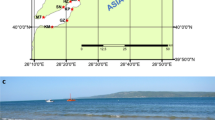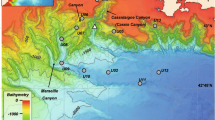Abstract
Sandy sediment and its infauna were annually sampled along the shallow waters of the Israeli coast during the 2005–2016 period, as a part of the Israeli National Environmental Program framework, aiming to detect anthropogenic interference in that province by monitoring changes in the species composition, abundance, and diversity of the infaunal communities and in accompanied abiotic parameters: the levels of total organic carbon and a series of heavy metals and the site-specific grain size distribution. The > 250-μm fraction of the fauna was segregated from the sampled sediment and was identified to species or higher taxonomic level. Three spatial biotopes were determined based on their unique faunal composition, Haifa Bay, Haifa harbor, and the southern coast. Species homogeneity among samples of each biotope was evaluated. Temporal and spatial changes of the species composition, abundance, and diversity were calculated for each biotope, mostly revealing random annual fluctuations. Only two minor temporal trends were observed: two spatially identical and temporally different faunal communities in the southern coast biotope, distinguishing the 2005–2007 and 2008–2016 periods, and a slight increase in the number of species across time in the two Haifa Bay provinces. Total organic carbon was highly correlated to the faunal composition with the highest organic carbon levels in the Haifa harbor biotope. The biotopes’ mutually occurring abundant species were sufficient to determine biotope borders and the contribution of intermittently sampled rare species, including the zoogeographically Indo-Pacific originated ones was feeble, important only to identify species migration and faunistics. Practically, three sampling sites along the Israeli shallow soft substrate, corresponding to the defined spatial biotopes, are sufficient to monitor the effect of environmental changes. Seasonal sampling twice a year is recommended as well as more accurate species identification using molecular taxonomy.








Similar content being viewed by others
References
Anderson, M. J., Gorley, R. N., & Clarke, K. R. (2008). PERMANOVA + for PRIMER, Guide to software and statistical methods. Plymouth: PRIMER-E Ltd 218 pp.
ASTM. (1983). Designation - D3683-78. Standard test method for trace elements in coal and coke ash by atomic absorption (pp. 472–475). Pennsylvania: American Society for Testing and Materials.
Bamber, R. N., Bird, G., Błażewicz Paszkowycz, M., & Galil, B. S. (2009). Tanaidaceans (Crustacea, Malacostraca, Peracarida) from soft-sediment habitats off Israel, Eastern Mediterranean. Zootaxa, 2109, 1–44.
Bareket, M. M., Bookman, R., Katsmana, R., de Stigter, H., & Herut, B. (2016). The role of transport processes of particulate mercury in modifying marine anthropogenic secondary sources, the case of Haifa bay, Israel. Marine Pollution Bulletin, 105, 286–291.
Bogi, C., & Galil, B. S. (2004). The bathybenthic and pelagic molluscan fauna off the Levantine coast, eastern Mediterranean. Bolletino di Malacologico, 39, 79–90.
Bogi, C., & Galil, B. S. (2006). Nuovi ritrovamenti lungo le coste Israeliane. Notizario, S.I.M 24, 16–18.
Bogi, C., & Galil, B. S. (2007). First record of Theora (Endopleura) lubrica Gould, 1861 (Mollusca, bivalvia, Semelidae) from a Levantine port. Aquatic Invasions, 2, 77–79.
Bogi, C., & Galil, B. S. (2013). New molluscan records from the eastern Mediterranean bathyal. Marine Biodiversity Records, 6, e19 (5 pp.).
Chao, A., & Jost, L. (2015). Estimating diversity and entropy profiles via discovery rates of new species. Method in Ecology and Evolution. https://doi.org/10.1111/2041-210X.12349.
Chao, A., Wang, Y. T., & Jost, L. (2013). Entropy and the species accumulation curve, a novel entropy estimator via discovery rates of new species. Methods in Ecology and Evolution, 4, 1091–1100.
Chao, A., Gotelli, N. J., Hsieh, T. C., Sander, E. L., Ma, K. H., Colwell, R. K., & Ellison, A. M. (2014). Rarefaction and extrapolation with Hill numbers, a framework for sampling and estimation in species diversity studies. Ecological Monogrphs, 84, 45–67.
Clarke, K. R., & Gorley, R. N. (2015). PRIMER v7, User Manual/Tutorial. Plymouth: PRIMER-E Ltd 300pp.
Clarke, K. R., Gorley, R. N., Somerfield, P. J., & Warwick, R. M. (2014). Change in marine communities: an approach to statistical analysis and interpretation (Vol. 3). Auckland: PRIMER-E Ltd 262 pp.
Dean, H. K. (2008). The use of polychaetes (Annelida) as indicator species of marine pollution, a review. Revista de Biología Tropical, 56, 11–38.
Eliani-Russak, E., Herut, B., & Sivan, O. (2013). The role of highly stratified nutrient-rich small estuaries as a source of dissolved inorganic nitrogen to coastal seawater, the Qishon (SE Mediterranean) case. Marine Pollution Bulletin, 71, 250–258.
Fauvel, P. (1955). Contribution a la faune des Annelides Polychetes des cotes d’Israel. Sea Fisheries Research Station, Haifa Bulletin, 10, 2–12.
Fauvel, P. (1957). Contribution a la faune des Annelides Polychetes des cotes d’Israel. II. Bulletin of the Research Council of Israel, 6B, 213–219.
Galil, B. S. (2004). The limit of the sea, the bathyal fauna of the Levantine Sea. Scientia Marina, 68(Suppl. 3), 63–72.
Gaudette, H. E., Flight, W. R., Toner, L., & Folger, D. W. (1974). An inexpensive titration method for the determination of organic carbon in recent sediments. Journal of Sedimentology and Petrology, 44, 249–253.
Goldsmith, S. L., Krom, M. D., Sandler, A., & Herut, B. (2001). Spatial trends in the chemical composition of sediments on the continental shelf and slope off the Mediterranean coast of Israel. Continental Shelf Research, 21, 1879–1900.
Gottlieb, E. (1960). The benthonic Amphipoda of the Mediterranean coast of Israel. I. Notes on the geographical distribution. Bulletin of the Research Council of Israel Section B, Zoology, 9b, 157–165.
Grassle, J. P., & Grassle, J. F. (1976). Sibling species in the marine pollution indicator Capitella (Polychaeta). Science, 192, 567–569.
Gray, J. S., & Elliot, M. (2009). Ecology of the marine sediment - from science to management (2nd ed.). Oxford: Oxford University Press reprinted in 2013, 223 pp.
Herut, B., & Galil, B. (2000). Environmental evaluation of the marine system along the coast of Israel (SE Mediterranean). Chapter 17. In C. Sheppard (Ed.), Seas at the millennium: an environmental evaluation (pp. 253–265). Amsterdam: Elsevier.
Herut, B., & Sandler, A. (2006). Normalization methods for pollutants in marine sediments, review and recommendations for the Mediterranean. IOLR Report H18/2006.
Herut, B., Hornung, H., Krom, M. D., Kress, N., & Cohen, Y. (1993). Trace metals in shallow sediments from the Mediterranean coastal region of Israel. Marine Pollution Bulletin, 26, 675–682.
Herut, B., Hornung, H., Kress, N., & Cohen, Y. (1996). Environmental relaxation in response to reduced contaminant input, the case of mercury pollution in Haifa Bay, Israel. Marine Pollution Bulletin, 32, 366–373.
Herut, B. et al. (2006-2011). Environmental quality of Israel’s Mediterranean coastal waters. IOLR Reports H25/2006, H49/2007, H52/2008, H77/2009, H64/2010, H68/2011.
Herut, B. et al. (2012-2017). The National Monitoring Program of Israel’s Mediterranean waters. IOLR Reports H78/2012, H62/2013, H21/2015, H42/2016, H48/2017.
Hsieh, T. C., Ma, K. H., & Chao, A. (2016). iNEXT, an R package for rarefaction and extrapolation of species diversity (Hill numbers). Methods in Ecology and Evolution, 7, 1451–1456.
Jones, M. B. (1973). Geographical and ecological distribution of Pariambus typicus (Krøyer) (Amphipoda, Caprellidae). Crustaceana, 25, 204–210.
Ozer, T., Gertman, I., Kress, N., Silverman, J., & Herut, B. (2017). Interannual thermohaline (1979–2014) and nutrient (2002–2014) dynamics in the Levantine surface and intermediate water masses, SE Mediterranean Sea. Global and Planetary Change, 151, 60–67.
R Core Team. (2016). R, A language and environment for statistical computing. Vienna: R Foundation for Statistical Computing.
Shefer, E., Silverman, J., & Herut, B. (2015). Trace metal bioaccumulation in Israeli Mediterranean coastal marine mollusks. Quarternary International, 390, 44–55.
Sorbe, J. C., Basin, A., & Galil, B. S. (2002). Contribution to the knowledge of the Amphipoda (Crustacea) of the Mediterranean coast of Israel. Israel Journal of Zoology, 48, 87–110.
Tsutsumi, H. (1987). Population dynamics of Capitella capitata (Polychaeta; Capitellidae) in an organically polluted cove. Marine Ecology Progress Series, 36, 139–149.
Vachtman, D., Sandler, A., Greenbaum, N., & Herut, B. (2012). Dynamics of suspended sediment delivery to the Eastern Mediterranean continental shelf. Hydrological Processes, 27, 1105–1116.
Volbehr, U., & Rachor, E. (1997). The association between the caprellid Pariambus typicus Krøyer (Crustacea, Amphipoda) and ophiuroids. Hydrobiologia, 355, 71–76.
Acknowledgments
The study was supported by the Israeli Ministries of Environmental Protection and Energy through the national monitoring program in Israel’s Mediterranean Waters. The sampling effort was led during the years 2005–2012 by Dr. Bella Galil who is highly appreciated. The commitment and assistance of the crew of R/V Shikmona and of the research assistants who participated in the sampling cruises and performed the laboratory tasks are deeply thanked, especially Ms. Eva Misrahi. The taxonomists who performed or supported the identification are thanked. They are Dr. Sabrina Lo Brutto, University of Palermo, Italy (Amphipoda); Dr. Graham Bird, Marine Biologist, Kāpiti, New Zealand (Tanaidacea); Dr. Jordi Corbera, Institut Cartografic de Catalunya, Spain (Cumacea); Dr. Bella Galil, Israel Oceanographic and Limnological Research (Decapoda); Dr. Cesare Bogi, Italy (Mollusca), Dr. Rony Huys, Natural History Museum, London, UK (Hexanauplia).
Author information
Authors and Affiliations
Corresponding author
Ethics declarations
Conflict of interest
The authors declare that they have no conflict of interest.
Additional information
Publisher’s note
Springer Nature remains neutral with regard to jurisdictional claims in published maps and institutional affiliations.
Electronic supplementary material
Rights and permissions
About this article
Cite this article
Lubinevsky, H., Herut, B. & Tom, M. Monitoring long-term spatial and temporal trends of the infaunal community characteristics along the shallow waters of the Mediterranean coast of Israel. Environ Monit Assess 191, 724 (2019). https://doi.org/10.1007/s10661-019-7872-7
Received:
Accepted:
Published:
DOI: https://doi.org/10.1007/s10661-019-7872-7




